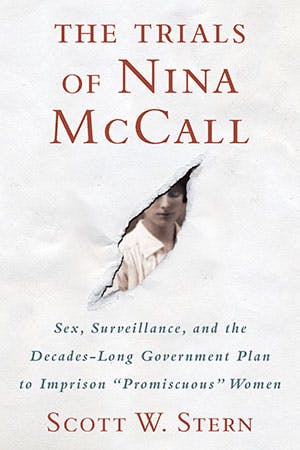In 1917, as World War I raged across the Atlantic, American government officials launched a program aimed at protecting newly-arrived army recruits from acquiring sexually-transmitted infections. It was assumed at that point that female sex workers and other “promiscuous” women were the primary carriers for STIs, and that the only way to keep America’s troops safe from the twin scourges of gonorrhea and syphilis was to limit their potential contact with these women. To this end, police and health officers gained the power to arrest and perform crude physical examinations on anyone (though the people they arrested were almost always women) they “reasonably suspected” of carrying an STI. Federal, state, and local officials were given free rein to enforce the state and national laws passed in the program’s wake, chief among which was the 1918 Chamberlain-Kahn Act.

As Scott Wasserman Stern details in his new book The Trials of Nina McCall: Sex, Surveillance, and the Decades-Long Government Plan to Imprison “Promiscuous” Women, if a woman was found to be sick, she was sent to a “detention hospital” (or to jail) until she was deemed cured or “reformed.” Some of those who tested negative for disease were incarcerated anyway, because their alleged promiscuity was deemed a threat to soldiers’ moral hygiene. A disproportionate number of those arrested were women of color and working class women; black women were often kept segregated from white women and jailed in subpar facilities, and, alongside other women of color, were subject to racist violence in addition to sexual assaults. Some were sterilized against their will, or without their knowledge.
Sex workers were the prime targets, but so was any woman deemed “suspicious”—which at that time could mean anything from being seen in the company of a soldier to eating alone in a restaurant. As the program became more firmly rooted within the legal system, with undercover agents from ASHA (American Social Hygiene Association) acting as its enforcers, a stark reality became apparent: Any woman, at any time, could legally be arrested, sexually assaulted, and hauled off to jail with no trial, no lawyer, and no idea when she’d be released. Those who were imprisoned in detention hospitals were subjected to involuntary medical examinations, inhumane living conditions, and treatments for gonorrhea and syphilis. Unfortunately, at that point, the most common “cure” for these diseases was a strict regimen of continuous doses of mercury and arsenic, toxic chemicals which poisoned these women’s bodies while doing absolutely nothing to cure their ills.
In 1918, 1,121 people in Michigan were “hospitalized at the expense of the state” because the authorities believed they had STIs. 49 were men; 1,072 were women, and one of them was a 19-year-old, impoverished white woman named Nina McCall. She was arrested, forcibly examined by a local health officer named Dr. Carney, deemed infected with gonorrhea and then syphilis, pumped full of arsenic, and imprisoned at the dilapidated Bay City Detention Hospital for three months. Like so many others, she found the courage to fight back. But instead of staging a prison riot or burning down the “reformatories,” as some of her incarcerated sisters did, Nina did something perhaps even more audacious for a working-class woman of her time. She took her tormentors to court.
In The Trials of Nina McCall, Stern situates Nina’s trials within the genesis of this program, tracing it from the early days of World War I through postwar progressivism, its reinvigoration at the outbreak of World War II, and throughout the civil rights era, as these laws continued to be enforced in some locales well into the 1970s. It ultimately became one of the largest-scale and longest-lasting mass quarantines in American history, though remains forgotten to an astonishing extent. It was named “the American Plan” (which is, confusingly, also the name of a plan that employers formulated in the 1930s to exploit the First Red Scare, deeming unions “anti-American.”)
There are survivors of this Plan’s state-sponsored sexual violence still alive today, and various forms of these original laws remain on the books in multiple states, having never been fully repealed. Nina McCall’s story might have stayed buried if Stern had skipped class the day in 2011 when one of his professors at Yale offhandedly mentioned that, “There were even concentration camps in this country for prostitutes.” That phrase rattled around in Stern’s mind, and he decided to find out more. The end result is this meticulously researched, utterly damning work that lays out just what measures the United States government took to control women’s sexuality and autonomy—and how perfectly happy local officials and law enforcement were to go along with it.
In its heyday, the Plan found supporters not only from conservatives but also from a number of liberal luminaries, from First Lady Eleanor Roosevelt and John D. Rockefeller Jr. (who bankrolled the program for decades) to California governor Pat Brown, a fondly-remembered Democrat who made his bones pursuing San Francisco “abortion queen” Inez Burns. They and other supporters took a pseudo-progressive stance, emphasizing about the importance of sex education, community services, and transparency about STIs; they saw themselves as the protectors of at-risk young women, and praised the razing of red-light districts while keeping mum on the plight of the women incarcerated across the country. Many of those in the medical community who opposed it did so solely because they rejected the idea of associating healthcare with federal government; to them, the Plan reeked of socialism.
There were women, like radical suffragist Edith Houghton Hooker and activist Katharine Bushnell, who campaigned against the Plan, advocating for its abolition on grounds of sexism and gross injustice. They found their efforts countered by reformists who were fine with the idea of locking up sex workers and “bad girls,” but who wanted to ensure that no innocents were swept up by mistake. Even the ACLU praised the Plan, only changing its tune in 1944 after a Northern California ACLU director named Ernest Besig took exception to San Francisco’s policy of holding all suspected women for 72 hours while they were examined.
Nina McCall’s wasn’t a particularly special case, and even her fight for justice wasn’t altogether unheard of. Nina stood out to Stern, both because of her sheer audacity and because the Michigan state archives happened to have kept detailed records of her case. In 1921, she took her case against those who had wronged her all the way to the Michigan Supreme Court and won. The court decided that Carney had erred in his treatment of her, because he had no reasonable grounds for suspicion that she had been infected; but that if he had, his actions would have been perfectly acceptable. Her victory proved bittersweet: The ruling—known as Rock v. Carney—went on to provide the justification for decades more abuses. The ASHA used it to bolster the right “of the health officer to quarantine persons suffering with the venereal disease in an infectious state who constitute a menace to the public health.”
After Nina faded from public view, her reputation restored, she married a young man named Norman, settled in Saginaw, Michigan, and tried to get on with things. In 1949, she and Norman moved to Bay City, the site of her incarceration and torture; there are no records to illuminate her feelings on the matter, but there they stayed, until she fell ill with a brain tumor and moved into a nursing home in 1957. Her three children had all died young; ultimately, at the age of 56, so did she.
After weathering decades of political turmoil and changing public sentiment, the American Plan ultimately lost steam in its most public form. Evolving attitudes towards sex, venereal disease, and women’s rights signaled a kind of death knell for this cruel dragnet, and several high-profile cases—including feminist writer Andrea Dworkin, who was arrested at the age of 18 when she attended an anti-war demonstration outside the United Nations building in New York City—helped hasten its retreat. After being strip-searched and forcibly examined by two male doctors, she bled for days afterwards. Around the same time, civil rights activists in Birmingham feared being subjected to the same kind of examinations at the hands of the police, and the Black Panthers in Sacramento risked forced “V.D. examinations” as part of a police harassment campaign.
Like Nina, Dworkin fought back, and attracted considerable media attention that led to an increased spotlight on the conditions women prisoners faced in New York City’s jails, and the eventual closure of the clinic at which she’d been assaulted. Pioneering sex workers’ rights organization COYOTE—led by local activist and former sex worker Margo St. James—took up the battle in San Francisco, and their efforts, in concert with those of ACLU lawyer Deborah Hinkley, resulted in a California Court of Appeals ruling that Oakland police would have to enforce the quarantine equally, regardless of the arrestee’s gender—which led to a sharp downtick in prostitution arrests. Similar battles played out across the nation, and by the mid-70s, the Plan—while not totally defeated—rested in tatters. In 1972, ASHA ceased its undercover surveillance and harassment of sex workers, instead pivoting towards more public-facing awareness campaigns and focusing on herpes, instead of syphilis or gonorrhea.
The ideas at the heart of the program have, however, proved remarkably resilient. Its tendrils of influence crept into the Tuskegee Syphilis Study, Japanese internment camps, and the responses to the AIDS epidemic, and helped to lay the groundwork for the current mass incarceration crisis. As Stern has uncovered, the same Civilian Conservation Corps (CCC) camps that were later used to imprison Americans of Japanese and German descent, prisoners of war, and conscientious objectors during World War II originally functioned as “concentration camps” for women incarcerated under the American Plan.
None of the three federal laws passed in 1917, 1918, and 1919 have ever been struck down in appeals court or repealed; they remain on the books in various forms today, and the toxic attitudes they enabled continue to impact women in America today. As late as 1976, authorities in Salt Lake City, Utah threatened the arrest and “forced treatment of suspected carriers of a strain of venereal disease that is resistant to penicillin treatment,” while police in California’s Monterey County required sex workers to submit to mandatory STI clinics, under threat of incarceration and forcible examination. In 1982, the mayor of Atlantic City floated the idea of quarantining sex workers in the name of “cleaning up” the boardwalk. When public officials detained a number of HIV-positive individuals in the 1980s and 1990s (many of them sex workers), the ghost of the American Plan reared its head once more; one court decision from 1990 directly cited a 1919 case that declared the quarantine of a woman infected with gonorrhea a “reasonable and proper” action. Everything old is new again.
The truths revealed in this book are truly shocking, and even more so because they are so little known. The culture of silence that has impacted sex workers for so long has finally begun to dissipate, but potent dangers remain. More than 200,000 women are currently incarcerated, and represent the fastest-growing segment of the prison population; up to 70 percent of women behind bars are or have been involved in the commercial sex industry. Women are still arrested on false pretenses, simply for how they look or present, or for carrying condoms in their purses; sex workers—particularly those who are trans women of color—are extremely vulnerable to police brutality and criminal justice abuses. Women like Nina McCall, Margo St. James, and Inez Burns fought against a system that saw them as less than human. One hopes the fact that more authors are now working to tell those stories means that more people will fight back.
